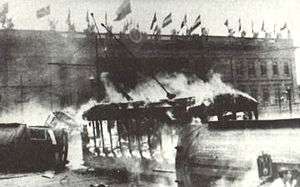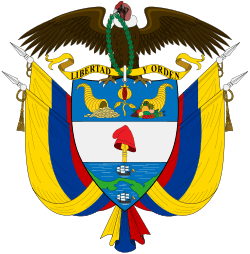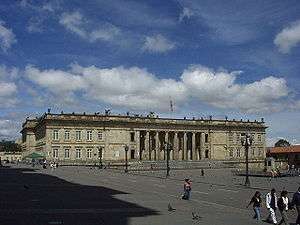La Violencia
| La Violencia | |||||||
|---|---|---|---|---|---|---|---|
| |||||||
| Belligerents | |||||||
|
| ||||||
| Commanders and leaders | |||||||
|
| ||||||
| Casualties and losses | |||||||
|
2,900 soldiers and 1,800 police officers dead (1948–57) 3,000–5,000 conservative paramilitaries dead |
15,000 rebels dead (1948–58) 170,000 civilians asassinated (1947–60) | ||||||
| La Violencia |
|---|
 |
| Prelude |
| Murder of Jorge Eliécer Gaitán |
| El Bogotazo |
| Political Parties |
| Liberal Party |
| Conservative Party |
| Colombian Communist Party |
| Presidents of Colombia |
| Mariano Ospina Pérez |
| Laureano Gómez |
| Gustavo Rojas Pinilla |
Part of a series on the |
||||||||||||||||||||
|---|---|---|---|---|---|---|---|---|---|---|---|---|---|---|---|---|---|---|---|---|
| History of Colombia | ||||||||||||||||||||
 | ||||||||||||||||||||
| Timeline | ||||||||||||||||||||
|
||||||||||||||||||||
|
| ||||||||||||||||||||
La Violencia (Spanish pronunciation: [la βjoˈlensja], The Violence) was a ten-year civil war in Colombia from 1948 to 1958, between the Colombian Conservative Party and the Colombian Liberal Party, fought mainly in the countryside.[1][2][3]
La Violencia is considered to have begun with the 9 April 1948 assassination of the popular politician Jorge Eliécer Gaitán, a Liberal Party presidential candidate for the election in November 1949. His murder provoked the Bogotazo rioting that lasted for ten hours and killed some 5,000 people.[4] An alternative historiography proposes as the start the Conservatives' return to power following the election of 1946. Rural town police and political leaders encouraged Conservative-supporting peasants to seize the agricultural lands of Liberal-supporting peasants, which provoked peasant-to-peasant violence throughout Colombia.[4]
La Violencia is estimated to have cost the lives of at least 200,000 people.[5][6][7]
Development

La Violencia took place between the paramilitary forces of the Colombian Liberal Party and the Colombian Conservative Party, which organized as armed self-defense groups and as guerrilla military units. Both also fought against the paramilitary forces of the Colombian Communist Party (PCC).
The conflict caused millions of people to abandon their homes and property. Media and news services failed to cover events accurately for fear of revenge attacks. The lack of public order and civil authority prevented victims from laying charges against perpetrators. Documented evidence from these years is rare and fragmented.
The majority of the population at the time was Catholic. During the conflict there were press reports that Catholic Church authorities supported the Conservative Party. Several priests were accused of openly encouraging the murder of the political opposition during Catholic mass, including the Santa Rosa de Osos Bishop Miguel Ángel Builes, although this is unproven. No formal charges were ever presented and no official statements were made by the Holy See or the Board of Bishops. These events were recounted in the 1950 book Lo que el cielo no perdona ("What heaven doesn't forgive"), written by the secretary to Builes, Father Fidel Blandon. Eduardo Caballero Calderón also recounted these events in his 1952 book El Cristo de Espaldas (Backwards Christ). After releasing his book, Blandon resigned from his position and assumed a false identity as Antonio Gutiérrez. However, he was eventually identified and legally charged and prosecuted.
As a result of La Violencia there were no liberal candidates for the presidency, congress, or any public corporations in the 1950 elections. The press accused the government of pogroms against the opposition. Censorship and reprisals were common against journalists, writers, and directors of news services. In consequence many media figures left the country. Jorge Zalamea, director of Critica magazine, fled to Buenos Aires; Luis Vidales to Chile; Antonio Garcia to La Paz, and Gerardo Molina to Paris.
Conclusion
Most of the armed groups (called bandoleros, a pejorative term) were demobilized during the amnesty declared by General Gustavo Rojas Pinilla after he took power on 13 June 1953. The most prominent bandolero leaders, Guadalupe Salcedo and Juan de la Cruz Varela, signed the 1953 agreement.
Some of the bandoleros did not surrender to the government, which caused intense military operations against them in 1954. One of them, the bandolero leader Tirofijo, had changed his political and ideological inclinations from being a Liberal to supporting the Communists during this period, and eventually he became the founder of the communist Revolutionary Armed Forces of Colombia or FARC.
Rojas was removed from power on 10 May 1957. Civilian rule was restored after moderate Conservatives and Liberals, with the support of dissident sectors of the military, agreed to unite under a bipartisan coalition known as the National Front and the government of Alberto Lleras Camargo and which included a system of alternating the president and power-sharing both in cabinets and public offices.
In 1958, Lleras Camargo ordered the creation of the Commission for the Investigation of the Causes of "La Violencia". The commission was headed by the Bishop Germán Guzmán Campos.
The last bandolero leaders were killed in combat against the army. Jacinto Cruz Usma, alias Sangrenegra (Blackblood), died in April 1964 and Efraín Gonzáles in June 1965.
Humanitarian consequences
Due to incomplete or non-existent statistical records, exact measurement of La Violencia's humanitarian consequences is impossible. Scholars, however, estimate that between 200,000 and 300,000 lives were lost; 600,000 to 800,000 were injured; and almost one million people were displaced. La Violencia directly or indirectly affected 20 percent of the population.[9]
La Violencia did not acquire its name simply because of the number of people it affected; it was the manner in which most of the killings, maimings, and dismemberings were done. Certain death and torture techniques became so commonplace that they were given names—for example, picar para tamal, which involved slowly cutting up a living person's body; or bocachiquiar, where hundreds of small punctures were made until the victim slowly bled to death. Former Senior Director of International Economic Affairs for the United States National Security Council and current President of the Institute for Global Economic Growth, Norman A. Bailey describes the atrocities succinctly: "Ingenious forms of quartering and beheading were invented and given such names as the 'corte de mica', 'corte de corbata' (aka Colombian necktie), and so on. Crucifixions and hangings were commonplace, political 'prisoners' were thrown from airplanes in flight, infants were bayoneted, schoolgirls, some as young as eight years old, were raped en masse, unborn infants were removed by crude Caesarian section and replaced by roosters, ears were cut off, scalps removed, and so on."[9] While scholars, historians, and analysts have all debated the source of this era of unrest, they have yet to formulate a widely accepted explanation for why it escalated to the notable level it did.
Historical interpretations
The death of the bandoleros and the end of the mobs was not the end of all the violence in Colombia. One communist guerrilla movement, the Peasant Student Workers Movement, started its operations in 1959.[10] Later, other organizations such as the FARC and the National Liberation Army emerged, marking the beginning of a guerrilla insurgency.
From the point of view of members of the FARC and the PCC, the Liberal and Conservative elites, though they had instigated the original violence, soon grew to fear the consequences of it and thus formed a loose alliance to preserve their shared desire for political hegemony from possible revolutionary challenges.
Credence in conspiracy theories as causes of violence
As was common of 20th-century eliminationist political violence, the rationales for action immediately before La Violencia were founded on conspiracy theories, each of which blamed the other side as traitors beholden to international cabals. The left were painted as participants in a global Judeo-Masonic conspiracy against Christianity, and the right were painted as agents of a Nazi-Falangist plot against democracy and progress.
Anticlerical conspiracy theory
After the death of Gaitán, a conspiracy theory circulating among the left, that leading conservatives and militant priests were involved in a plot with Nazis and Falangists to take control of the country and undo the country's moves toward progress, spurred the violence.[11] This conspiracy theory supplied the rationale for Liberal Party radicals to engage in violence, notably the anti-clerical attacks and killings, particularly in the early years of La Violencia. Some propaganda leaflets circulating in Medellín blamed a favorite of anti-Catholic conspiracy theorists, the Society of Jesus (Jesuits), for the murder of Gaitán.[12]
Across the country, militants attacked churches, convents, and monasteries, killing priests and looking for arms, since the conspiracy theory maintained that the religious had guns, and this despite the fact that not a single serviceable weapon was located in the raids.[11] One priest, Pedro María Ramírez, was slaughtered with machetes and hauled through the street behind a truck, despite the fact that the militants had previously searched the church grounds and found no weapons.[12]
Despite the conspiracy theories and propaganda after Gaitán's killing, most on the left learned from their errors in the rioting on 9 April, and stopped believing that priests had harbored weapons.[13]
The claims by both camps of the existence of some sort of conspiracy made the political environment toxic, increasing the animosity and suspicion of both parties.[14]
Judeo-Masonic conspiracy theory
Conservatives likewise had been motivated to fight against a supposed international Judeo-Masonic conspiracy by eliminating the Liberals in their midst.[15] In the two decades prior to La Violencia, Conservative politicians and churchmen adopted from Europe the Judeo-Masonic conspiracy theory to portray the Liberal Party as involved in an international anti-Christian plot, with many prominent Liberal politicians actually being Freemasons.[16]
Although the rhetoric of conspiracy was in large part introduced and circulated by some of the clergy, as well as by Conservative politicians, by 1942 many clerics were critical of the Judeo-Masonic conspiracy theory. Jesuits outside of Colombia had already questioned and published disputes of the authenticity of The Protocols of the Elders of Zion, which was already proven to be an anti-Semitic fictional literary forgery incorporating plagiarisms dating back to at least the mid-1800s, pushing the concept of a global Judeo-Masonic conspiracy. Colombian clergy were also increasingly influenced in this matter by U.S. clergy; and Pius XI had asked U.S. Jesuit John LaFarge, Jr. to draft an encyclical against anti-Semitism and racism.[17] Allegations of a Judeo-Masonic conspiracy played most prominently in the politics of Laureano Gómez, who directed the Colombian Conservative Party from 1932 to 1953.[18] More provincial politicians followed suit, and the fact that prominent national and local politicians were voicing this conspiracy theory, rather than just a portion of the clergy, gave the idea greater credibility while it gathered momentum among the party members.
The atrocities that had happened at the outset of the Spanish Civil War in 1936 were seen by both sides as a possible precedent for Colombia, causing both sides to fear it could happen in their country; this also spurred the credibility of the conspiracies and the rationale for violence.[14] Catholics everywhere were shocked by the wave of anticlerical violence in the Republican zones in Spain in the first months of that war where anarchists, socialists and communists burned churches and murdered nearly 7,000 priests, monks, and nuns.[14]
See also
Notes
- ↑ Stokes, Doug (2005). America's Other War: Terrorizing Colombia. Zed Books. ISBN 1-84277-547-2.
Azcarate quotes a figure of 300,000 dead between 1948–1959...
- ↑ Gutierrez, Pedro Ruz (31 October 1999). "Bullets, Bloodshed And Ballots". Orlando Sentinel. Archived from the original on 2016-06-25.
Political violence is not new to that South American nation of 38 million people. In the past 100 years, more than 500,000 Colombians have died in it. From the 'War of the Thousand Days,' a civil war at the turn of the century that left 100,000 dead, to a partisan clash between 1948 and 1966 that claimed nearly 300,000...
- ↑ Bergquist, Charles; Robinson, David J. (2005). "Colombia". Microsoft Encarta Online Encyclopedia 2005. Microsoft Corporation. Archived from the original on 2009-10-31. Retrieved 16 April 2006.
On April 9, 1948, Gaitán was assassinated outside his law offices, in downtown Bogotá. The assassination marked the start of a decade of bloodshed, called La Violencia (The Violence), which took the lives of an estimated 180,000 Colombians before it subsided in 1958.
- 1 2 Livingstone, Grace; foreword by Pearce, Jenny (2004). Inside Colombia: Drugs, Democracy, and War. Rutgers University Press. p. 42. ISBN 0-8135-3443-7.
- ↑ Britannica, 15th edition, 1992 printing
- ↑ Palmowski, Jan (1997). A Dictionary of Twentieth Century World History. Oxford University Press. ISBN 9780192800169.
- ↑ Grenville, J.A.S. (1994). A History of the World in the 20th Century.
- ↑ "El día que mataron a Gustavo Jiménez". El Tiempo (in Spanish). 7 September 1999. Archived from the original on 2016-06-26.
- 1 2 Bailey, Norman A. (1967). "La Violencia in Colombia". Journal of Inter-American Studies. Center for Latin American Studies at the University of Miami. 9 (4): 561–75. doi:10.2307/164860. JSTOR 164860.
- ↑ Archived June 26, 2007, at the Wayback Machine.
- 1 2 Williford 2005, p. 218.
- 1 2 Williford 2005, p. 277.
- ↑ Williford 2005, p. 278.
- 1 2 3 Williford 2005, p. 185.
- ↑ Williford 2005, p. 217.
- ↑ Williford 2005, p. 142.
- ↑ Williford 2005, p. 197.
- ↑ Williford 2005, p. 178.
References
- Williford, Thomas J. (2005-05-26). Armando los espiritus: Political Rhetoric in Colombia on the Eve of La Violencia, 1930–1945 (Dissertation). Vanderbilt University.
Further reading
- Rempe, Dennis M. (Winter 1995). "Guerrillas, Bandits, and Independent Republics: US Counter-insurgency Efforts in Colombia 1959-1965". Small Wars and Insurgencies. 6 (3): 304–27. Archived from the original on 30 March 2010.
- Wirpsa, Leslie. Economics fuels return of La Violencia